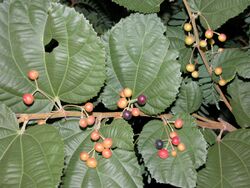Biology:Grewia asiatica
| Grewia asiatica | |
|---|---|

| |
| Flowers and leaves | |

| |
| Scientific classification | |
| Kingdom: | Plantae |
| Clade: | Tracheophytes |
| Clade: | Angiosperms |
| Clade: | Eudicots |
| Clade: | Rosids |
| Order: | Malvales |
| Family: | Malvaceae |
| Genus: | Grewia |
| Species: | G. asiatica
|
| Binomial name | |
| Grewia asiatica | |
| Synonyms[2] | |
| |
Grewia asiatica, commonly known as phalsa[3] or falsa,[4] is a species of flowering plant in the mallow family Malvaceae. It was first found in Varanasi, India, and was taken by Buddhist scholars to other Asian countries including Pakistan and the rest of the world.[4][5] Grewia celtidifolia was initially considered a mere variety of phalsa, but is now recognized as a distinct species.
It is a shrub or small tree growing to 8 m tall. The leaves are broadly rounded, 5–18 cm long and broad, with a petiole 1–1.5 cm long. The flowers are produced in cymes of several together, the individual flowers about 2 cm diameter, yellow, with five large (12 mm) sepals and five smaller (4–5 mm) petals. The fruit is an edible drupe 5–12 mm diameter, purple to black when ripe.[4][6]
Cultivation and uses
It is extensively cultivated for its sweet and sour acidic fruit, which is sold in the market during the summer months under the name falsa. The flower blooms in April and the fruit is ripe by the end of May. It is available for a very short period in the market, and is at its maximum[clarification needed] by the middle of June. A Sharbat or squash is prepared from the fruit pulp by mixing it with sugar and used as an astringent, stomachic and cooling agent.
The root is used by Santhal tribals for rheumatisms. The stem bark is said to be used in refining sugar, for making ropes and its infusion is used as a demulcent. The leaves are used as an application to pustular eruptions. The buds are also prescribed by some physicians.[7]
It has become naturalised and locally invasive in Australia and the Philippines .[5][6][8]
References
- ↑ Botanic Gardens Conservation International (BGCI).; IUCN SSC Global Tree Specialist Group (2019). "Grewia asiatica". IUCN Red List of Threatened Species 2019: e.T147027384A147027386. doi:10.2305/IUCN.UK.2019-2.RLTS.T147027384A147027386.en. https://www.iucnredlist.org/species/147027384/147027386. Retrieved 20 November 2021.
- ↑ "Grewia asiatica L.". Board of Trustees of the Royal Botanic Gardens, Kew. http://powo.science.kew.org/taxon/urn:lsid:ipni.org:names:834064-1.
- ↑ {{citation | mode = cs1 | title = Grewia asiatica | work = Germplasm Resources Information Network (GRIN) | url = | publisher = [[Organization:Agricultural Research ServAgricultural Research Service (ARS), United States Department of Agriculture (USDA) | access-date = 20 June 2021 }}
- ↑ 4.0 4.1 4.2 Flora of India Grewia asiatica
- ↑ 5.0 5.1 Pacific Island Ecosystems at Risk: Grewia asiatica
- ↑ 6.0 6.1 Flora of Western Australia: Grewia asiatica
- ↑ Purdue University: Fruits of warm climates: Phalsa
- ↑ Yadav, A. K. (1999). Phalsa: A Potential New Small Fruit for Georgia. pp.348–352 in: Janick, J. (ed.). Perspectives on new crops and new uses. ASHS Press. Available online.
Wikidata ☰ Q1998501 entry
 |


